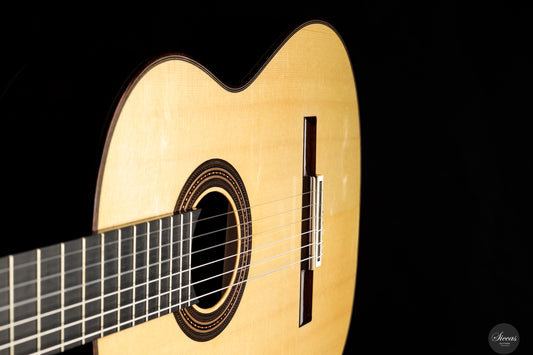
How to Play Classical Guitar: Tips from Alexandra Whittingham – Part 1
Mastering the classical guitar requires dedication, technique, and the right practice routine. In this first part of Alexandra Whittingham's tutorial series, she shares her valuable tips for warming up, practicing, and improving overall performance on the classical guitar. Whether you're new to the instrument or refining your skills, Alexandra's expert advice will help you elevate your playing.
Start with a Warm-Up Routine
A well-structured warm-up is essential for preparing your hands and fingers before diving into more complex pieces. Alexandra recommends a warm-up session lasting around 10 to 15 minutes. She emphasizes the importance of tailoring your warm-up to the pieces you're going to practice that day, whether you're working on scales, arpeggios, or technical exercises.
Her go-to warm-up exercises include scales and arpeggios, along with studies that target specific techniques. These exercises not only get your fingers moving but also help develop the dexterity and muscle memory needed for intricate classical guitar pieces.
Focus on Technique-Based Exercises
One of the key points Alexandra mentions is the benefit of incorporating technique-focused exercises into your routine. She often adapts her warm-up based on the pieces she plans to practice that day. For example, if you're working on a piece with fast arpeggios, include exercises that enhance right-hand coordination and precision.
For players who deal with cold hands, like Alexandra, she suggests spending extra time warming up the hands, especially focusing on the right hand, which is often more susceptible to cold. This helps maintain fluidity and control when playing.
Right-Hand Exercises
A crucial aspect of classical guitar playing is the right hand, which is responsible for plucking the strings with precision. Alexandra emphasizes that right-hand exercises are vital for developing control and speed. She often starts with basic finger exercises, working on getting the fingers to move smoothly and evenly across the strings.
Right-hand arpeggios are particularly effective in building finger independence and strengthening muscle memory. Alexandra's warm-up routine includes alternating patterns to help develop a balanced, controlled sound.
Tailor Your Routine to the Music
Alexandra encourages guitarists to tailor their practice routine based on the pieces they're working on. If a particular piece requires a specific technique, make sure to include exercises that focus on those skills. This ensures that your warm-up is directly beneficial to your playing for the day.
For example, if you're practicing a piece with challenging arpeggios or fast scales, dedicate extra time to exercises that improve those techniques. This approach not only helps you build muscle memory but also makes your practice session more efficient.
Key Takeaways from Alexandra's Tutorial
- Warm-Up Matters: Start with 10 to 15 minutes of warm-up exercises. Include scales, arpeggios, and technique-focused drills that prepare your fingers for the day's practice.
- Right-Hand Focus: Spend extra time on right-hand exercises, especially if you're working on pieces that demand precision and speed. This builds the dexterity and control necessary for advanced classical guitar playing.
- Tailor Your Routine: Adjust your warm-up based on the pieces you're practicing. Incorporating technique-specific exercises makes your routine more effective.
Conclusion
In this first part of Alexandra Whittingham's classical guitar tutorial series, she highlights the importance of a strong warm-up routine and provides practical advice on how to tailor your practice for optimal results. By focusing on right-hand exercises and technique-based warm-ups, you'll not only improve your skillset but also ensure your hands are ready for more complex pieces.
Stay tuned for more tips in Alexandra's classical guitar tutorial series. In the next part, she dives deeper into specific techniques and how to incorporate them into your practice.


















